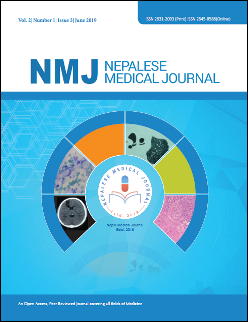Diagnostic Role of Lymphnode Imprint: A Cyto-histopathological Correlation
DOI:
https://doi.org/10.3126/nmj.v2i1.24053Keywords:
Carcinoma, Imprint, Lymph node, TuberculosisAbstract
Introduction: Lymphadenopathy is a very common condition for which excision biopsy is often recommended when fine needle aspiration cytology is not conclusive. Lymph node imprint cytology is a useful and rapid alternative diagnostic tool. This study was conducted to assess the accuracy of lymph node imprint cytology as compared to the histopathology.
Materials and Methods: Imprint smears were made from all cases of lymphadenopathy. The smears were evaluated by three pathologists and categorized into, inflammatory lesions and primary and metastatic tumors. Imprint smears were made from lymph node excision specimens and were stained with PAP and MGG stains. The diagnosis in imprints was compared with those given by histopathology. With the help of sensitivity, specificity & accuracy, the agreement between the imprint smear and histopathology was determined.
Results: Among the total 92 cases, 40 (43.4%) cases were chronic non-specific lymphadenitis, 22 (23.9%) were tuberculosis and metastatic lesions each. The overall accuracy of lymph node imprint cytology was 96.73%, 96.74%, 96.74% and 100% for tuberculosis, chronic non-specific lymphadenitis, lymphoma, and metastatic lesions respectively.
Conclusions: Lymph node imprint smears is a rapid diagnostic tool and can be used routinely as an adjunct to histopathology in the diagnosis of various lymph node disorders.
Downloads
Downloads
Published
How to Cite
Issue
Section
License
This license enables reusers to distribute, remix, adapt, and build upon the material in any medium or format, so long as attribution is given to the creator. The license allows for commercial use.
Copyright on any article published by Nepalese Medical Journal is retained by the author(s).
Authors grant Nepalese Medical Journal a license to publish the article and identify itself as the original publisher.
Authors also grant any third party the right to use the article freely as long as its integrity is maintained and its original authors, citation details and publisher are identified.




